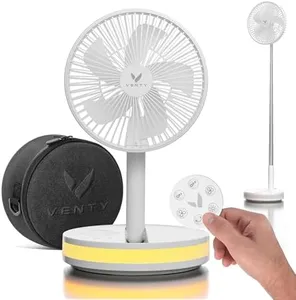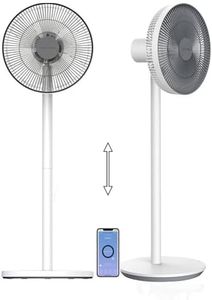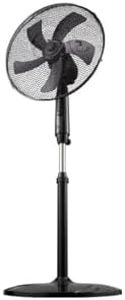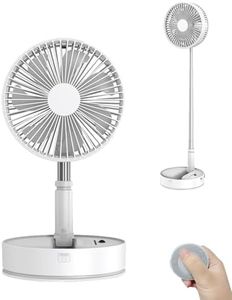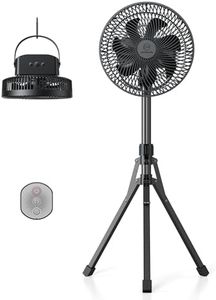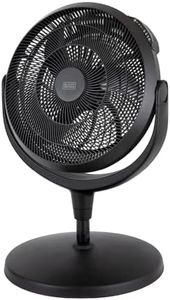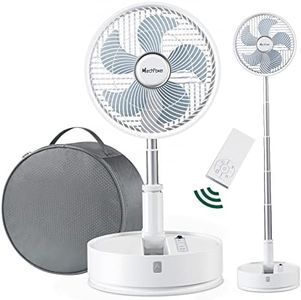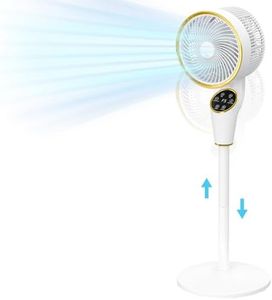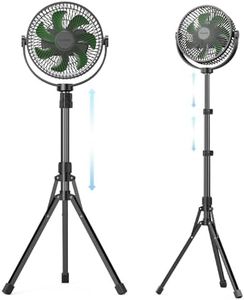We Use CookiesWe use cookies to enhance the security, performance,
functionality and for analytical and promotional activities. By continuing to browse this site you
are agreeing to our privacy policy
10 Best Outdoor Standing Fans
From leading brands and best sellers available on the web.Buying Guide for the Best Outdoor Standing Fans
When shopping for an outdoor standing fan, it's important to focus on features that will keep you comfortable outside while ensuring safety and long-lasting use. Your choice should be guided by where and how you plan to use the fan—whether it's for a patio dinner, a garage workout, or cooling people at an outdoor event. Think about the size of the area, the climate, and how portable or weather-resistant the fan needs to be. Understanding the key specifications will help you pick the right fan for your specific outdoor environment.Airflow (CFM)Airflow, often measured in cubic feet per minute (CFM), indicates how much air the fan can move. This is important for determining how well the fan will cool an area. Lower CFM (under 2000) is suitable for small patios or solo use, while medium CFM (2000–4000) can cool a group or moderate spaces. For large gatherings or open spaces, a high CFM (above 4000) is best. If you want a gentle breeze while relaxing, go lower; for strong airflow during workouts or parties, opt for higher CFM.
Durability and Weather ResistanceOutdoor fans need to withstand exposure to moisture, sunlight, and sometimes dust or debris. This is usually marked by materials like rust-resistant metal or high-grade plastic, and may be indicated by an IP (Ingress Protection) rating. Basic outdoor fans handle occasional moisture, while more robust models withstand heavy rain or constant outdoor use. If your fan will be left outside often, prioritize weather resistance; for occasional use in sheltered areas, a less durable model may suffice.
Oscillation and Adjustable HeightOscillation means the fan head can turn from side to side, helping to distribute air over a wider area. Adjustable height lets you point the airflow exactly where you need it. Fixed fans provide breeze in one direction, good for focused cooling. Oscillating, adjustable fans are better for covering multiple seats around a table or a larger area. Pick according to whether you need broad coverage or targeted airflow.
Speed SettingsMultiple speed settings let you control how strong or gentle the airflow is. Some fans offer just two or three speeds, while others have variable controls. This is valuable for adapting to different weather conditions or preferences. If you want customization for different activities or temperature changes, look for more speed options. If you only need a consistent breeze, fewer settings may be enough.
Power SourceOutdoor fans may plug into a standard electrical outlet, run on batteries, or use rechargeable power sources. Plug-in fans offer steady power for long use, but need to be near an outlet. Battery-powered fans give you flexibility to use them anywhere, but may have shorter run times. If you have easy outdoor access to electricity, plug-in is reliable; if you need to move the fan around or use it far from an outlet, consider battery or rechargeable models.
Portability and StabilityThis covers how easy the fan is to move and whether it stays securely in place. Light fans with wheels or handles are easier to transport but may tip over in wind. Heavier bases provide stability for windy days but can be harder to relocate. If you’ll move the fan often, look for portable models; if it’s staying put, a stable, sturdy base is best for safety.
Noise LevelOutdoor fans vary in how much noise they make. Lower noise is important if you’ll use the fan for relaxing, dining, or conversation. Fans with larger blades often run quieter at lower speeds, while high-speed fans can be louder. Consider where you’ll use the fan: for quiet patios, choose a quieter option; for noisy gatherings, noise may not matter as much.


